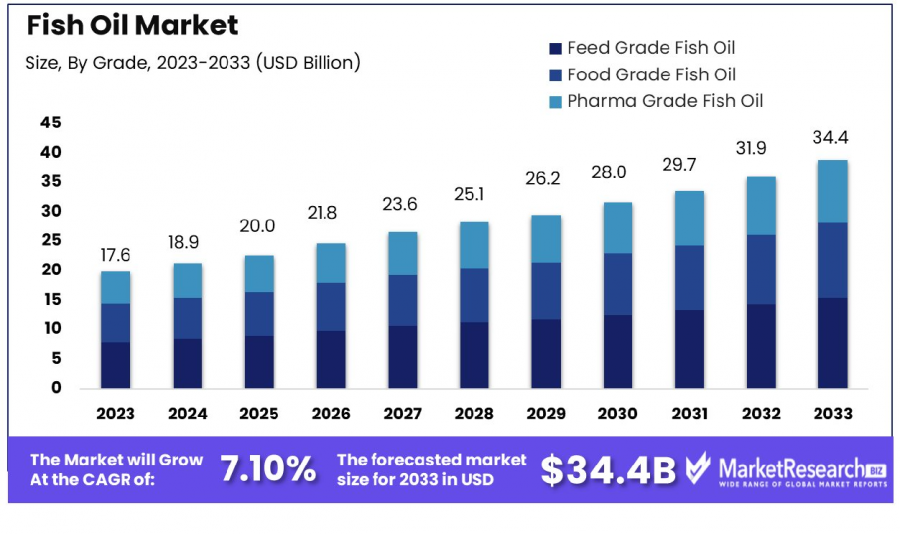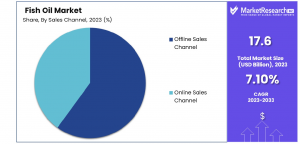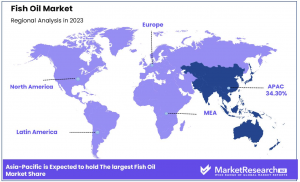
Fish Oil Market Value To Surpass USD 34.4 Billion by 2033, To Develop Speedily With CAGR Of 7.10% By 2033
The Fish Oil Market was valued at USD 17.6 billion in 2023. It is expected to reach USD 34.4 billion by 2033, with a CAGR of 7.10% from 2024 to 2033.
NEW YORK, NY, UNITED STATES, February 14, 2025 /EINPresswire.com/ -- The global Fish Oil Market is experiencing substantial growth, with a valuation of USD 17.6 billion in 2023, projected to reach USD 34.4 billion by 2033 at a CAGR of 7.10%. Fish oil, rich in omega-3 fatty acids like EPA and DHA, is vital for cardiovascular health, cognitive function, and reducing inflammation, making it a staple in dietary supplements and food and beverage industries. The market is segmented into feed-grade, food-grade, and pharma-grade fish oil, catering to diverse applications such as aqua-feed, dietary supplements, and cosmetics.
Geographically, Asia-Pacific holds a leading position due to its robust aquaculture production, while Europe and North America follow, driven by consumer awareness of health benefits. The sector's growth is supported by rising health consciousness and technological advancements in extraction and production methods, which enhance the quality and efficacy of fish oil products. However, challenges such as stringent regulations and environmental concerns remain, necessitating strategic adaptations by market players.
➤ 𝐒𝐚𝐦𝐩𝐥𝐞 𝐑𝐞𝐩𝐨𝐫𝐭 𝐑𝐞𝐪𝐮𝐞𝐬𝐭: 𝐔𝐧𝐥𝐨𝐜𝐤 𝐕𝐚𝐥𝐮𝐚𝐛𝐥𝐞 𝐈𝐧𝐬𝐢𝐠𝐡𝐭𝐬 𝐟𝐨𝐫 𝐘𝐨𝐮𝐫 𝐁𝐮𝐬𝐢𝐧𝐞𝐬𝐬: https://marketresearch.biz/report/global-fish-oil-market/request-sample/
Experts Review
Governments are encouraging sustainable practices through incentives and certifications, crucial for maintaining ecological balance and ensuring long-term supply. Technological innovations in extraction and refinement improve product quality, essential for meeting escalating consumer demands. Investment opportunities are abundant with the expansion of e-commerce platforms, though risks include regulatory compliance costs and environmental issues. Increasing consumer awareness about fish oil’s health benefits is driving sales, though companies must adapt to stringent regulatory environments to maintain product integrity and market trust.
Report Segmentation
The Fish Oil Market is segmented by grade (feed, food, pharma), process (crude, refined, modified), product (anchovy, salmon, tuna oil, etc.), end-user (aqua-feed, food and beverages, dietary supplements, cosmetics), and sales channel (offline and online). Feed-grade fish oil dominates due to its use in aquaculture, which comprises the primary consumer segment. By product type, anchovy oil leads, attributed to its high omega-3 content, while by sales channel, offline sales dominate due to consumer preference for in-person product evaluation. Geographically, Asia-Pacific leads with a significant share due to extensive aquaculture activities, followed by Europe and North America, driven by technological advancements and health awareness.
By Grade
• Feed Grade Fish Oil
• Food Grade Fish Oil
• Pharma Grade Fish Oil
By Process
• Crude Fish Oil
• Refined Fish Oil
• Modified Fish Oil
By Product
• Anchovy Oil
• Salmon Oil
• Tuna Oil
• Cod Liver Oil
• Sardine Oil
• Squalene Oil
• Krill Oil
• Menhaden Oil
• Others
By End User
• Aqua-feed [Crustaceans, Eels, Cyprinids, Marine Fish, Salmon & Trout, Tilapias]
• Food & Beverages
• Dietary Supplements
• Cosmetic & Beauty Products
By Sales Channel
• Offline Sales Channel [Supermarkets/Hypermarkets, Departmental Stores, Convenience Store, Other Sales Channel]
• Online Sales Channel [Company Website, E-commerce Platform]
➤ 𝐁𝐮𝐲 𝐍𝐨𝐰 𝐭𝐡𝐢𝐬 𝐏𝐫𝐞𝐦𝐢𝐮𝐦 𝐑𝐞𝐩𝐨𝐫𝐭 𝐭𝐨 𝐆𝐫𝐨𝐰 𝐲𝐨𝐮𝐫 𝐁𝐮𝐬𝐢𝐧𝐞𝐬𝐬: https://marketresearch.biz/purchase-report/?report_id=23451
Drivers, Restraints, Challenges, and Opportunities
Key drivers include the rising health awareness about omega-3 benefits and the growth of aquaculture, which sustains the fish oil supply. However, the market faces restraints from commoditization and price competition, which squeeze profit margins, and stringent regulations that increase compliance costs. Challenges include maintaining sustainable sourcing amid environmental concerns and adapting to diverse consumer preferences. Conversely, opportunities arise from the demand for sustainable products and the expansion of e-commerce channels, providing platforms for direct consumer engagement and diversified product formats to attract broader consumer demographics.
Key Player Analysis
Prominent players such as TripleNine Group, FMC Corporation, and Omega Protein Corporation play crucial roles in the Fish Oil Market. These companies leverage technological advancements and adhere to sustainability practices to maintain a competitive edge. Their focus on product innovation, such as enhanced omega-3 formulations, addresses consumer demand and regulatory standards. Their strategic initiatives in sustainable sourcing and processing efficiency position them favorably to meet global demand, particularly in key application sectors like dietary supplements and aquafeed.
• Marvesa Holding N.V.
• Pesquera Diamante S.A.
• Foodcorp Chile S.A (Austevoll Seafood ASA)
• DSF
• FMC Corporation
• Pelagia AS
• TripleNine Group A/S
• Croda International PLC
• Omega Protein Corporation
• OLVEA Fish Oils (OLVEA)
• Camanchaca
• China Fishery Group Limited
• Corpesca S.A.
• Oceana Group Limited
• Colpex International
• FF Skagen A/S
• Pesquera Exalmar
• Copeinca AS
• BASF SE
• DSM
• Koninklijke DSM N.V.
Recent Developments
Recent industry developments include a noted decline in global fish oil production due to environmental challenges, with reports indicating a 30% decrease in production. Such constraints emphasize the need for innovations like plant-based omega-3 alternatives. Companies are increasingly investing in new delivery formats, such as flavored and powdered fish oils, to cater to consumer preferences. Sustainability remains a focal area, with firms obtaining certifications to reassure environmentally conscious consumers and mitigate the impact of regulatory pressures.
Conclusion
The Fish Oil Market is set to witness robust growth driven by health trends, technological innovations, and consumer demand for dietary supplements and functional foods. While challenges such as regulatory compliance and environmental sustainability persist, the market offers significant opportunities for players who innovate and adapt strategically. Embracing sustainable practices and tapping into the expanding e-commerce landscape will be key to capitalizing on future growth prospects.
Lawrence John
Prudour
+91 91308 55334
Lawrence@prudour.com
Distribution channels: Food & Beverage Industry
Legal Disclaimer:
EIN Presswire provides this news content "as is" without warranty of any kind. We do not accept any responsibility or liability for the accuracy, content, images, videos, licenses, completeness, legality, or reliability of the information contained in this article. If you have any complaints or copyright issues related to this article, kindly contact the author above.
Submit your press release


